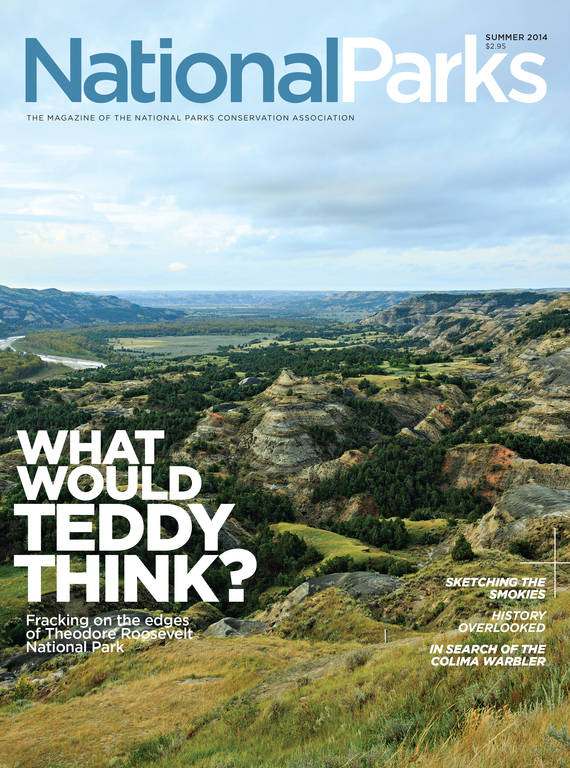Summer 2014
Raising the Bar
Massimo Vignelli died in May, but his design lives on in the national parks.
You may not know his name, but you’ve seen his work a million times. The logos for Bloomingdale’s, Ford, American Airlines, and Benetton? All created by Massimo Vignelli. The distinctive signage in the New York City subway system—quintessential Vignelli. The National Park Service brochures that appear in every single park unit in the country? Yep, Vignelli too.
In 1977, Vignelli created a system that gave an idiosyncratic hodgepodge of park brochures a coherent, legible, identifiable look that has been in use ever since. Dubbed the Unigrid, the plan dictates everything from the font, type sizes, column width and folds, to the signature black bar and the overall layout.
BY THE NUMBERS
“I think it’s one of the most important projects in our career,” Vignelli says in “Design is One,” a film completed a year before his death on May 27. The documentary highlights his career and partnership with Lella Vignelli, his wife and lifelong collaborator on design projects from books to jewelry, furniture, and showrooms.
The film, which has been on the festival circuit and is scheduled for home release later this year, is a poignant reminder of the elegance of the iconic creation Vignelli made for the Park Service. The Unigrid has evolved over 37 years—even Vignelli conceded that change was inevitable—but the underlying structure remains and admirers of the design say it is timeless.
“Every designer dreams that they will design something that has these kinds of legs. And very few do,” says Jessica Helfand, who co-founded the blog, “Design Observer,” and teaches design at Yale University. “As much as critics might say that the Unigrid is restrictive, limiting the variables has allowed it to achieve such long-lasting power. It’s an architectural principle at its core. You wouldn’t build a house without a foundation… It’s bedrock—typographical bedrock.”
Park brochures have existed since before the Park Service was created a century ago. The railroads originally created them to increase ridership, and while the guides have changed over the decades to keep pace with new travel patterns and the expansion of the park system, they had never been standardized until Vincent Gleason became chief of the division of publications in 1962. Gleason successfully pushed for color—the Government Printing Office had previously restricted the colors to black and white for almost everything—and made the inspired decision to hire Vignelli to revamp the brochures in the mid-1970s. Gleason reasoned that a consistent approach would help him manage the office’s budget and increasing workload.
Vignelli’s solution was a grid-based, organization plan that limited the brochures to 10 basic sizes and formats. The Unigrid system limited waste by fitting snugly into standard-size paper. It established the famous black bar, which conveyed the organization’s identity in a heartbeat, and visually linked all the park units. It was branding long before branding was a ubiquitous catchword.
“There’s a systematic method to the madness here,” says Melissa Cronyn, associate manager of the Harpers Ferry Center publications office, where all the brochures are designed. “The idea was that we would have these formats to choose from instead of worrying about how it was folded and size and so forth. It would leave us free to explore innovation and imagination related to the content and not have to go back and constantly reinvent the wheel. Having lived through that era of many varieties of brochures and ways of folding, it definitely saves time and money.”
Designers were skeptical at first, but as they became conversant with the system, the grumbling faded, Cronyn says. Now they talk about being converts.
“The system is amazingly flexible,” says Angie Faulkner, a graphic designer at Harpers Ferry Center. The black bar “goes with everything and enhances everything,” she says.
Despite this loyalty, the design staff has been willing to tweak the prototype as tastes have shifted and technology has transformed the field. To begin with, in 2001, the original fonts were replaced to improve legibility. Vignelli’s Helvetica and Times New Roman were switched to Frutiger and NPS Rawlinson, a font designed specifically for the Park Service. In addition, the white typeface on the front panel is slightly smaller than it used to be, to accommodate longer names and a slightly narrower black band.
The parks’ beloved maps, which are streamlined to focus on the most useful information for visitors, have also evolved. Cartographers have the technology to make three-dimensional maps, for example, and they’ve moved away from using flat tones in oceans, skies, and other big patches.
The designs used to be boxier with big, unbroken walls of text and rows of images. It was clean and modern but came to seem static. The updated brochures look more organic, with more silhouetted, or cutout, images and maps that blend into the page. The brochure for New Orleans Jazz National Historical Park is downright animated compared to some early Unigrids—a decision Faulkner made to reflect the human story and the improvisational nature of jazz.

National Parks
You can read this and other stories about history, nature, culture, art, conservation, travel, science and more in National Parks magazine. Your tax-deductible membership donation of $25 or more entitles…
See more ›At the same time, the trend has been to shift away from an encyclopedic approach to one that features more digestible nuggets of information, minimal text, and more graphics. “You don’t need ten tons of information,” Cronyn says. “In these types of brochures, it’s more important to find the information quickly. That’s true in travel literature in general.”
The Unigrid, which is not copyrighted, has been imitated around the country and world. Various state parks, the U.S. Fish and Wildlife Service, and national parks as far away as Australia have adopted the black band, which has practically become a global signifier of “park.” The Park Service design staff sees that as a testament to the brilliance of the original. They could talk all day on the topic, though they tend to demur when asked about their favorites. But Don Kodak, the director of Harpers Ferry Center, was willing to say that his favorite is always the one he’s used last. Right now, that’s the brochure for Yellowstone National Park, which he recently visited with 20 family members.
“Back at the ranch where we were staying, everyone was marking their copy where they wanted to go and where we would meet up.” They all had iPhones and other devices, but those don’t help much in areas of the park that lack cell-phone service.
“At the end of the day,” he says, “we counted on the park’s Unigrid more than anything else.”
About the author
-
 Rona Marech Editor-in-Chief
Rona Marech Editor-in-ChiefRona Marech is the editor-in-chief of National Parks, NPCA’s award-winning magazine. Formerly a staff writer at the Baltimore Sun and the San Francisco Chronicle, Rona joined NPCA in 2013.



